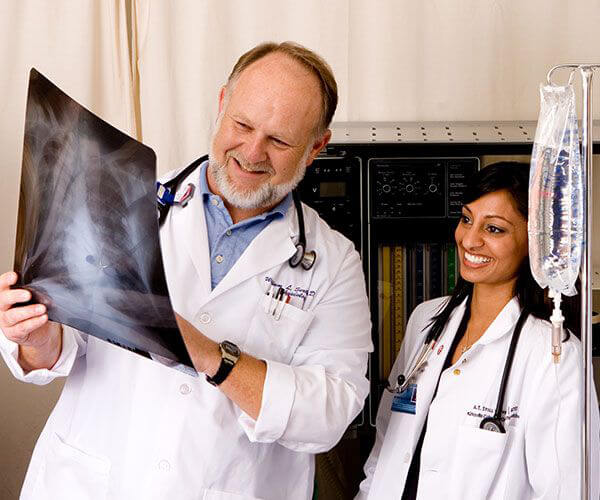Program Competencies and Performance Measures
| PANCE Performance* *The CCPA program has received provisional accreditation The most recent PANCE score report is available here | |||||
| Class | Graduation Year | Number first time takers | Program First Time Taker Pass Rate | National First Time Taker Pass Rate | % of Candidates Who Ultimately Passed PANCE |
| 2023 | 2023 | 88 | 68% | 92% | 95% |
| 2024 | 2024 | 80 | 55% | 92% | 85% |
| 2025 | 2025 | 61 | 84% | 92% | 85% |
| 2026 | 2026 | —— | —— | —— | —— |
| 2027 | 2027 | —— | —— | —— | —— |
Program Attrition
|
| Graduated Classes | |||
| Class of 2023 | Class of 2024 | Class of 2025 | Class of 2026 | |
| Maximum entering class size (as approved by ARC-PA) | 90 | 90 | 90 | 90 |
| Entering class size | 90 | 90 | 90 | 89 |
| Graduates | 88 | 82 | # | # |
| * Attrition rate | 2% | 8.89% | # | # |
| * Attrition Rate for Diverse Students | 0% | 9.4% | # | # |
| **Graduation rate | 98% | 91.11% | # | # |
*Attrition rate calculation: Number of students who attritted from cohort divided by the entering class size.
**Graduation rate: Number of cohort graduates divided by the entering class size.
# No data yet available.
CCPA Program Goals
-
Goal 1: Matriculate a cohort of students from diverse backgrounds.+
-
Benchmark
- Matriculate a greater national average, than other PA programs, of diverse and underrepresented students
- Maintain an annual attrition rate of <10% of diverse and underrepresented students
Data Source
- For Benchmark #1
- PAEA PA Program race data from Program Report 36
- U.S. 2020 Census information
- NACHC Data Updated 2023
- Program Demographic data from CCPA admissions materials
- For Benchmark #2
- Student attrition rates with demographic data
Demographic US Pop 2020 Nat CHC Patient Pop PA Program Comparison From PAEA 2024 Data Report CCPA CO2023 CCPA CO2024 CCPA CO2025 Class of 2026 White (non-Hispanic) 57.8% 41% 76.9% 37.78% 21% 42% 52.22% Asian 5.77% 4.1% 12.8% 15.56% 13% 27% 28.89% Native Hawaiian/Pacific Islander Not Specified 0.8% 3.1% 1.11% 2% 1% 5.56% American Indian/Alaska Native (URM) 0.84% 1% 1.4% 1.11% 1% 6% 5.56% Multiracial Not Specified 2.4% 7.9% 17.78% 16.85% 54.65% 53.33% African American/Black 12.1% 19.8% 7% 8.89% 18% 17% 12.22% Hispanic/Latino 18.7%% 31.9% 11.5% 28.89% 40% 37% 32% %URM 31.64% 60.8% 19.9% 38.89% 59% 60% 49.78% Income At or Below 100% Fed Poverty Limit 11.1% 66% Data Not available from PAEA 34.1% (economically disadvantaged) 62% (economically disadvantaged) 66.7% (economically disadvantaged) 52% (economically disadvantaged) - Please see program attrition rate chart above.
Results
-
-
Goal 2: Develop graduates with the medical knowledge and skills to deliver evidence-based, patient-centered primary health care.+
-
Benchmark
- First time taker PANCE pass rate >85%.
- On the End of Clinical Year and Exit Survey (formerly the Graduate Exit Survey), delivered at the end of the clinical year, new graduates will report >3.5 (on a 5 point likert scale) on questions pertaining to obtaining the knowledge and skills to deliver evidence-based patient-centered primary healthcare.
Data Source
- PANCE Pass rate data table from NCCPA
- End of Clinical Year and Exit Survey (formerly the Graduate Exit Survey)
Results
- Please see the PANCE performance chart above.
- On the Graduate Exit Survey, students are asked to rate their education on incorporating knowledge of etiologies, risk factors, underlying pathologic process, and epidemiology for medical conditions into diagnosis, management, and patient education
- 2023 graduates rated this as a 4.2 on a 5.0 Likert scale.
- 2024 graduates rated this as a 3.7 on a 5.0 Likert scale.
Graduate Exit Survey Results CO2024 CO2023 Response Rates 28 (34%) 55 (63%) Item 14 Incorporate knowledge of etiologies, risk factors, underlying pathologic process, and epidemiology for medical conditions into diagnosis, management, and patient education. 3.6 4.1 Item 17 Incorporate knowledge of etiologies, risk factors, underlying pathologic process, and epidemiology for medical conditions into diagnosis, management, and patient education. 3.7 4.2 Mean: 3.7 4.2 - On the End of Clinical Year and Exit Survey, students are asked to rate their education on obtaining the knowledge and skills needed to deliver evidence-based primary care.
- 2025 graduates rated this as a 3.9 on a 5.0 Likert scale.
-
-
Goal 3: Prepare culturally competent graduates equipped with the skills necessary to care for underserved communities.+
-
Benchmark
- 100% of students complete at least one clinical rotation in an underserved area or a community health center located in a designated Health Professional Shortage Area (HPSA).
- On student graduate exit surveys, graduates will report >3.5 (on a 5 point likert scale) on preparedness to serve underserved communities.
- Cohort median of Preceptor Evaluation of Student (Cultural awareness) >3.5 (on a 5 point likert scale)
Data Source
- Clinical site student assignment scheduled and clinical site demographics/data
- End of Clinical Year survey
- Preceptor evaluations of students
Results
- Benchmark #1 Results
- 100% of students in the Class of 2023 completed Supervised Clinical Patient Experiences (SCPEs) in designated Health Professional Shortage Areas (HPSA).
- 100% of students in the Class of 2024 completed Supervised Clinical Patient Experiences (SCPEs) in designated Health Professional Shortage Areas (HPSA)
Students completing a rotation in a CHC or URIM in each cohort 2025 2024 2023 Number of students completing at least two rotations at a CHC or in a HPSA area. 91 87 88 Number of students NOT completing at least two rotations at a CHC or in a HPSA area 0 0 0 Percentage of each cohort meeting goal #3 100% 100% 100% Total entering cohort size 91 87 88 - Benchmark #2 Results
- On the End of Clinical Year/Graduate Exit survey, 2023 graduates rated their ability to recognize the cultural norms, needs, influences, and socioeconomic, environmental, and other population-level determinants affecting the health of the individual and community being served, and ability to incorporate them into evaluation and management of the patient as a 4.5 on a 5.0 Likert scale.
- On the End of Clinical Year survey, 2024 graduates rated their ability to recognize the cultural norms, needs, influences, and socioeconomic, environmental, and other population-level determinants affecting the health of the individual and community being served, and ability to incorporate them into evaluation and management of the patient as a 4.1 on a 5.0 Likert scale.
Student Graduate Exit Survey Results 2024 2023 Response Rates 28 (34%) 55 (63%) 4 point likert scale questions Cultural Proficiency (needed for clinical practice in primary care) 3.7 3.7 Social Responsibility: The ability to engage in initiatives and activities that positively impact the health and well-being of the individuals, communities and professions served.(Examples: advocating for health, wellness and access to healthcare; participating in community health and wellness outreach activities; participating in professional organizations and/or scholarship to advance health and well-being; following thecode of ethics.) - Social Responsibility 3.2 3.5 Average 4 Point Likert Scale Questions: 3.5 3.6 5 point Likert scale question Recognize the cultural norms, needs, influences, and socioeconomic, environmental, and other population-level determinants affecting the health of the individual and community being served, and incorporate them into evaluation and management of the patient. 4.1 4.5 The curriculum increased my understanding of social responsibility and prepared me to serve underserved communities. (Program Goal #3, OQ9) 4.0 The curriculum prepared me to recognize the cultural norms, needs, influences, and social determinants of health of patients and communities and incorporate them into appropriate patient care. (Program Goal #3, OQ15) 4.0 Average 5 Point Likert Scale Questions: 4.0 4.5 - Benchmark #3 Results
- On the preceptor evaluation of students, Preceptors rated the class of 2023 students’ cultural humility/skills necessary to care for underserved communities as an average of 4.56 on a 5.0 Likert scale.
- On the preceptor evaluation of students, Preceptors rated the class of 2024 students’ cultural humility/skills necessary to care for underserved communities as an average of 4.50 on a 5.0 Likert scale.
Preceptor Evaluation of Students CO2024 CO2023 Response Rates 86 (100%) 88 (100%) Response Rates 5 point Likert scale questions Students’ cultural humility/skills necessary to care for underserved communities: ” Recognizes the cultural and socioeconomic influences affecting patient health and offers culturally sensitive patient guidance and care related to these factors.” 4.5 4.6
-
CCPA Program Graduate Competencies
| Medical Knowledge |
| MK1- Apply the knowledge of foundational medical sciences to provide appropriate, evidence-based, culturally competent patient care. |
| Clinical and Technical Skills |
| CTS1- Elicit a comprehensive, detailed, and accurate patient history. |
| CTS2- Perform an appropriate physical examination on a patient with accurate technique. |
| CTS3- Perform basic technical procedures used in primary care. |
| Clinical Reasoning and Problem-Solving Abilities |
| CRPS1a- Formulate a working diagnosis. |
| CRPS1b- Interpret diagnostic studies. |
| CRPS2- Formulate comprehensive patient management plans. |
| Interpersonal Skills |
| IS1- Demonstrate respectful, clear, and culturally competent communication with patients. |
| IS2- Communicate medical information accurately to members of the interprofessional healthcare team. |
| Professional Behaviors |
| PB1- Demonstrate an understanding of the guidelines that drive the PA profession. |
| PB2- Exhibit professional behaviors in interactions with patients and the healthcare team. |

